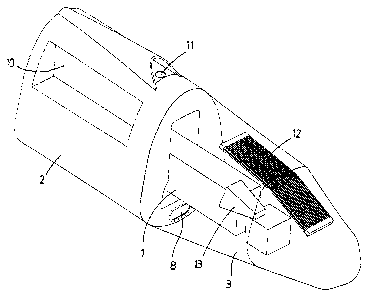Some of the information on this Web page has been provided by external sources. The Government of Canada is not responsible for the accuracy, reliability or currency of the information supplied by external sources. Users wishing to rely upon this information should consult directly with the source of the information. Content provided by external sources is not subject to official languages, privacy and accessibility requirements.
Any discrepancies in the text and image of the Claims and Abstract are due to differing posting times. Text of the Claims and Abstract are posted:
| (12) Patent: | (11) CA 2573624 |
|---|---|
| (54) English Title: | UNMANNED HELICOPTER COMPRISING A SELF-SUPPORTING HOUSING |
| (54) French Title: | HELICOPTERE TELECOMMANDE A BOITIER AUTOPORTEUR |
| Status: | Granted and Issued |
| (51) International Patent Classification (IPC): |
|
|---|---|
| (72) Inventors : |
|
| (73) Owners : |
|
| (71) Applicants : |
|
| (74) Agent: | ROBIC AGENCE PI S.E.C./ROBIC IP AGENCY LP |
| (74) Associate agent: | |
| (45) Issued: | 2013-10-29 |
| (86) PCT Filing Date: | 2005-05-27 |
| (87) Open to Public Inspection: | 2006-01-19 |
| Examination requested: | 2010-03-30 |
| Availability of licence: | N/A |
| Dedicated to the Public: | N/A |
| (25) Language of filing: | English |
| Patent Cooperation Treaty (PCT): | Yes |
|---|---|
| (86) PCT Filing Number: | PCT/AT2005/000183 |
| (87) International Publication Number: | WO 2006005087 |
| (85) National Entry: | 2007-01-12 |
| (30) Application Priority Data: | ||||||
|---|---|---|---|---|---|---|
|
The invention relates to an unmanned helicopter comprising an internal
combustion engine and an associated fuel tank. The unit (1) formed by the
internal combustion engine and the gearbox is arranged essentially in a self-
supporting housing (2) which is at least partially closed all the way round,
and preferably consists of carbon fibre-reinforced plastic (CFK), a nose body
(3) being connected to the front of said housing. In this way, a compact
structure can be achieved.
L'invention concerne un hélicoptère télécommandé comportant un moteur à combustion interne et un réservoir à carburant correspondant. L'unité (1) formée par le moteur à combustion interne et la transmission est essentiellement logée dans un boîtier autoporteur (2) au moins partiellement fermé périphériquement, de préférence réalisé en plastique renforcé par fibres de carbone, un corps de nez (3) étant monté sur l'avant dudit boîtier. Ainsi, on obtient une structure compacte.
Note: Claims are shown in the official language in which they were submitted.
Note: Descriptions are shown in the official language in which they were submitted.

2024-08-01:As part of the Next Generation Patents (NGP) transition, the Canadian Patents Database (CPD) now contains a more detailed Event History, which replicates the Event Log of our new back-office solution.
Please note that "Inactive:" events refers to events no longer in use in our new back-office solution.
For a clearer understanding of the status of the application/patent presented on this page, the site Disclaimer , as well as the definitions for Patent , Event History , Maintenance Fee and Payment History should be consulted.
| Description | Date |
|---|---|
| Inactive: IPC expired | 2023-01-01 |
| Common Representative Appointed | 2019-10-30 |
| Common Representative Appointed | 2019-10-30 |
| Change of Address or Method of Correspondence Request Received | 2018-12-04 |
| Maintenance Request Received | 2015-05-07 |
| Maintenance Request Received | 2014-02-28 |
| Grant by Issuance | 2013-10-29 |
| Inactive: Cover page published | 2013-10-28 |
| Pre-grant | 2013-08-13 |
| Inactive: Final fee received | 2013-08-13 |
| Notice of Allowance is Issued | 2013-05-27 |
| Letter Sent | 2013-05-27 |
| Notice of Allowance is Issued | 2013-05-27 |
| Inactive: Approved for allowance (AFA) | 2013-05-23 |
| Maintenance Request Received | 2013-04-15 |
| Amendment Received - Voluntary Amendment | 2012-12-13 |
| Inactive: S.30(2) Rules - Examiner requisition | 2012-06-22 |
| Amendment Received - Voluntary Amendment | 2012-02-22 |
| Inactive: S.30(2) Rules - Examiner requisition | 2011-12-02 |
| Inactive: IPC assigned | 2011-10-14 |
| Inactive: Correspondence - MF | 2010-08-10 |
| Letter Sent | 2010-04-14 |
| Request for Examination Received | 2010-03-30 |
| Request for Examination Requirements Determined Compliant | 2010-03-30 |
| All Requirements for Examination Determined Compliant | 2010-03-30 |
| Inactive: Cover page published | 2007-03-20 |
| Inactive: Notice - National entry - No RFE | 2007-03-09 |
| Letter Sent | 2007-03-09 |
| Application Received - PCT | 2007-02-09 |
| National Entry Requirements Determined Compliant | 2007-01-12 |
| Application Published (Open to Public Inspection) | 2006-01-19 |
There is no abandonment history.
The last payment was received on 2013-04-15
Note : If the full payment has not been received on or before the date indicated, a further fee may be required which may be one of the following
Please refer to the CIPO Patent Fees web page to see all current fee amounts.
Note: Records showing the ownership history in alphabetical order.
| Current Owners on Record |
|---|
| SCHIEBEL INDUSTRIES AG |
| Past Owners on Record |
|---|
| HANS-GEORG SCHIEBEL |